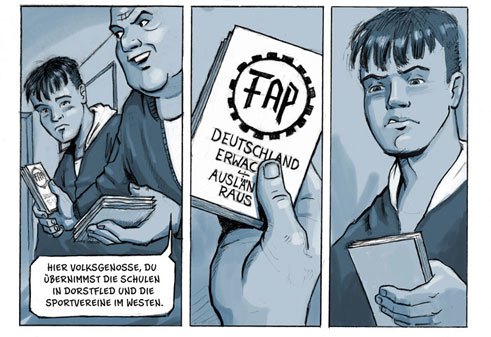Graphic Novels
Combating neo-Nazis through comics

Nils Oskamp and David Schraven engage with the subject of right-wing extremism in their graphic novels. The illustrators offer a profound insight into this world of violence and hatred.
A young man is being beaten up by neo-Nazis in a dark alleyway; they only leave him alone once his body is motionless. “Daddy, get up!” – a little boy wakes his father. The thugs are merely a nightmare. “Phew, everything is okay”, thinks the father, but his memories of the past are still vivid. This is the opening scene to Nils Oskamp’s autobiographical graphic novel Drei Steine (i.e. Three Stones).
Born in Bochum in 1969, Oskamp learnt how to fight. As a schoolboy, he used his fists to fight against neo-Nazis at his school. These days he uses his pencil to combat and draw attention to the evils in society. In Drei Steine he depicts his experiences of racism and ostracism and uses flashbacks to describe his time at Wilhelm Busch School in Dortmund-Dorstfeld.
Everyone looks the other way
His memories are anything but sentimental. A new boy at school broadcasts his right-wing extremist and fascist ideology. Oskamp resists – and is beaten up and humiliated. The teachers look the other way, the parents are unable to cope. The spiral of violence escalates. One day, Oskamp is attacked so brutally that he only regains consciousness in hospital. At this point he reports the crime to the police. There is a court case. The thugs are sentenced to 20 hours of community service for attempted murder. Oskamp leaves the city.The journalist David Schraven also focuses on the neo-Nazi scene. His graphic novel Weiße Wölfe (i.e. White Wolves) is about Albert S., a neo-Nazi member of a cell in Dortmund known as Combat 18 – the name the militant arm of the neo-Nazi “Blood & Honour” network gives itself. The book is based on work conducted by Correctiv, an investigative newsroom run by David Schraven. Through investigative research, Schraven has reconstructed the life of Albert S. in a story illustrated by Jan Feindt.
David Schraven made a conscious decision to publish the results of his research in the form of a graphic report and to make them available free of charge online so as to reach young readers. “It makes no sense to bury one’s head in the sand and to believe that the evil will disappear provided one ignores it for long enough. We have to face up to the horror in order to combat it”, he writes on the Correctiv website.
Breaking through the spiral of violence
Nils Oskamp took a different approach. Unlike the investigative journalist David Schraven, he chose not to penetrate ever deeper into the far-right scene, preferring instead to pursue his work in private. He resists, fights – and then realizes that he must break through the spiral of violence. A central role in the story is played by the three eponymous stones which he noticed during a visit to a Jewish cemetery in Dortmund-Dorstfeld. As he explains, working on the comic also had a therapeutic effect for him: “I banished the demons and the rage of my past into the pages of the comic.”Oskamp learnt the skills of his trade early on: after leaving school, he studied illustration at the art academy in Bochum, worked as a graphic designer and art director and then set up in business as a commercial artist. Every two years he attends Franco-German comic seminars in Erlangen. His tutors encouraged him to pursue his career as an illustrator, so he enrolled at Hamburg Animation School. His graduate thesis film Voodee, a parable about captivity and marginalization, won him the 2003 Hamburg “Animation Award”. Nowadays Oskamp illustrates medical instructions and storyboards, designs icons and logos and illustrates magazine texts and advertising brochures.
In 2002, he joined forces with colleagues and founded “Illustratoren Organisation e.V.”, the German Association of Illustrators, which now has more than 1,200 members. In 2003 he launched an international art campaign for the European Parliament in Brussels, entitled “Art Against Female Genital Mutilation”. He also established “Atelier sans Frontières”, a Franco-German artists’ collective. Oskamp has been working on the Drei Steine project since 2007. He presented initial designs and preparatory work at the 2008 Comic Salon in Erlangen, the leading comic festival in the German-speaking world. His book was published by the Amadeu Antonio Foundation in 2015 in an abridged version for schools, and in 2016 will be published in its entirety by Panini Verlag. In the illustrator’s opinion, comics are a good way to encourage “kids of the computer-game generation” to read.